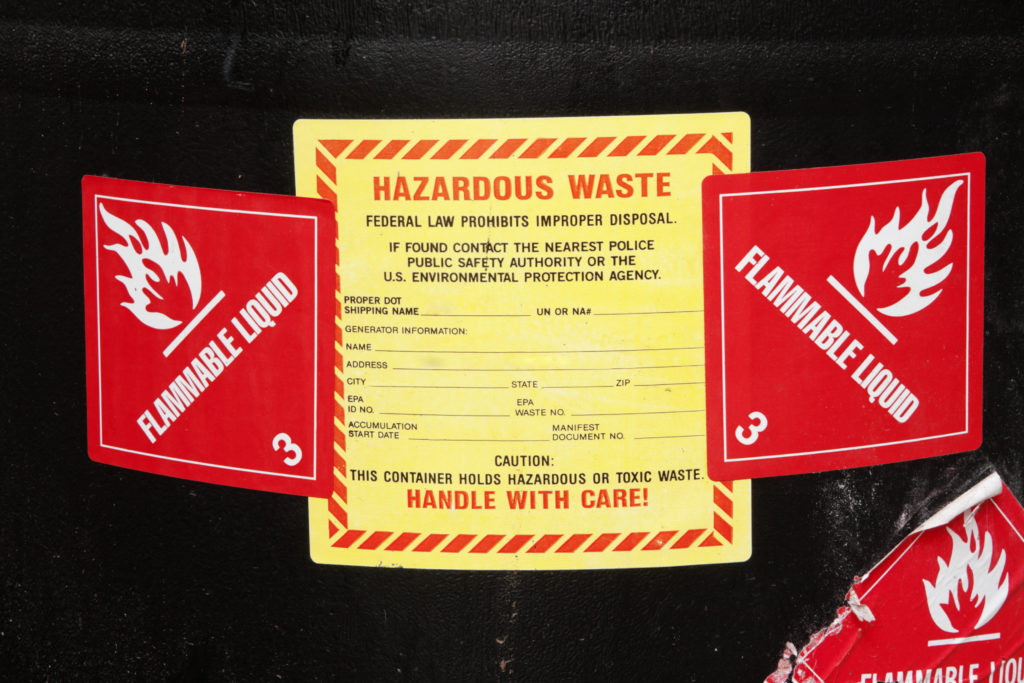
Guest column: Hazardous waste management in auto body shops
By onBusiness Practices | Education | Legal | Repair Operations
By Wade Scheel, Stericycle
Auto body shops typically generate several types of potentially hazardous waste — primarily oil-based, solvent-based paints and paint-related materials. Other forms of hazardous waste in shop settings range from coatings to absorbents, solvents, non-empty containers, paint booth filters, solvent rags, used oils, antifreeze and more. Many of these wastes must clearly be managed as hazardous, while others may require regulated waste management expertise to make that determination.
Hazardous waste compliance in the collision repair industry is of the utmost importance for several reasons. The safety of employees and the environment is a foremost concern. Improperly managed hazardous wastes can be ignitable, flammable or toxic and can cause serious injury to employees and the environment. From a regulatory perspective, the Environmental Protection Agency (EPA) can fine up to $72,718 day per violation, especially for repeat offenders. As an example, if a shop has a container storing hazardous waste without a lid properly secured on it, the EPA has the authority to determine how long the violation has occurred and can then fine the shop for every day of the non-compliance. Fines can also vary state by state.
State vs. federal government requirements
In the U.S., when it comes to hazardous waste management, states can impose standards stricter than those of the federal government. As a result, certain materials that are not regulated as solid or hazardous waste under the federal Resource Conservation and Recovery Act (RCRA) may be regulated under a state’s RCRA program.
Additionally, materials that are considered hazardous waste vary state by state. For example, the California Department of Toxic Substances Control in 2006 outlined potentially hazardous waste in auto body shops, including contaminated rags, sanding or grinding dusts, contaminated waste waters and more.
The EPA established basic hazardous waste management standards for businesses that produce hazardous waste and categorized them based on the volume of hazardous waste produced in a calendar month. On the federal level, there are three generator categories: very small quantity generator (VSQG), small quantity generator (SQG) and large quantity generator (LQG).
Some states are authorized to establish generator categories that differ from those established by the federal government. To help current and potential hazardous waste generators follow state regulations, the EPA lists the states that have regulations differing from federal regulations and which states have the same generator categories. EPA also lists links to rules or guidance for those states that have different regulations.
It’s important to note is that there are different weight limits for the various hazardous wastes that are generated at a location as well as time limits for how long that waste can remain on-site. Many body shops do not produce over 220 pounds of hazardous waste in a single month and are therefore VSQGs. VSQGs can accumulate their hazardous waste indefinitely, as long as they don’t exceed 2,200 pounds of waste onsite at any time. SQGs have 180 days to ship their waste offsite for disposal, while LQGs are often required to ship their hazardous waste offsite for disposal within 90 days.

Best practices
When it comes to adhering to state and federal regulations, auto body shop owners and managers can be overwhelmed by the technical expertise required to ensure proper compliance. The following best practices will help owners and managers get on the path to proper hazardous waste management.
Label containers: Once the hazardous waste is placed in a drum or tank, the container must be properly labeled as required by regulations. Containers should be marked as “hazardous waste,” “non-hazardous waste” or “universal waste” and include the accumulation start date as well as an indication of the hazardous characteristic of the contents. It is also best management practice to include the contents on the label. If an inspector from the city, state or federal EPA visits the shop, proper labeling is one of the first things they will examine. States often have specific hazardous waste labeling requirements and may require regular inspections of hazardous waste accumulation containers and storage areas.
Close the container: In addition to proper labeling, all containers storing hazardous waste must be kept closed, except when adding or removing wastes. In addition, it’s important to ensure all containerized wastes are not leaking. Many body shops store hazardous waste in 55-gallon drums, which can weigh up to 500 pounds. As soon as containers are full, they should be disposed of as soon as possible.
Segregate incompatible chemicals: Incompatible hazardous wastes must remain separate, so it’s recommended to use separate accumulation bins or drums that are designated for each specific categories of waste. For example: aerosols, flammables, toxics, corrosive acidic, corrosive alkaline (basic), oxidizers and universal waste.
Ensure proper storage: All hazardous waste should be stored in a dedicated, permanent, clean and organized hazardous waste area. The ideal location is away from traffic areas, electrical panels, perishable or consumable product storage and dock doors. The containers should be placed on an impervious surface, such as pavement or tile, without floor drains.
Keep proper records: Maintaining an inventory log will help shop owners manage and track waste generation volumes. Every time an item is identified as hazardous waste and placed into an accumulation container, it should be noted on the log and kept in the shop’s records. Without proper record-keeping and thorough paperwork, shops run the risk of being fined.
Call an expert: With regulations varying state by state as well as on a federal level, it can be extremely helpful to have a highly trained expert come on-site to identify best practices for managing the waste being generated. Small businesses like body shops are being more heavily regulated today as they can be easy targets for non-compliance. Don’t wait until a city, state or government inspector shows up at the door. Be prepared in advance by relying on trained experts who can help evaluate your hazardous waste streams and ensure proper compliance.
Common missteps
A common mistake with hazardous waste management in auto body shops is the mixing of different types of wastes in one container in an attempt to save money. This can be an especially dangerous practice, with the potential for the container to ignite, explode or leak, causing serious harm to employees and the environment.
In addition, some shops cut the tops off of storage drums or small tanks to make it easier to dump chemicals inside the container; however, that makes it more difficult for the hazardous waste to be transferred off-site and can also result in an expensive regulatory penalty.
In one recent instance, a small body shop was piling buckets
of flammable solvents in a corner of a small shed with some of the hazardous
waste leaking onto the ground. Machinery and equipment were in the area and could
have caused a fire.
Images:
Wade Scheel is director of governmental affairs for Stericycle Environmental Solutions.
A hazardous waste label is shown. (SteveDF/iStock)
